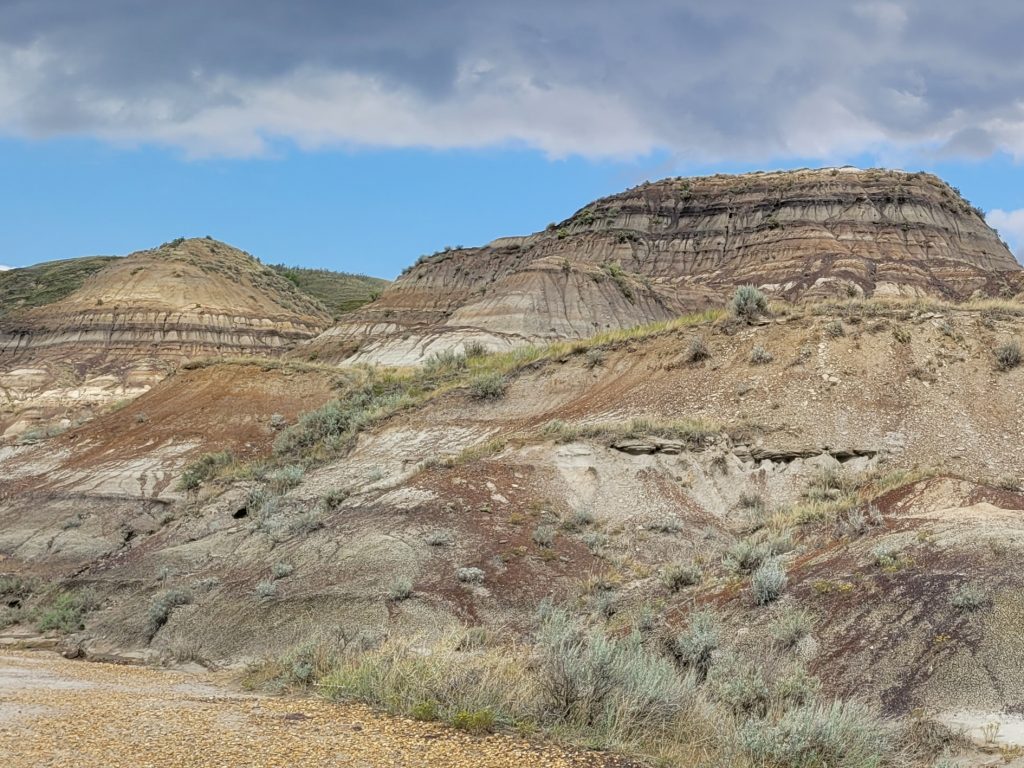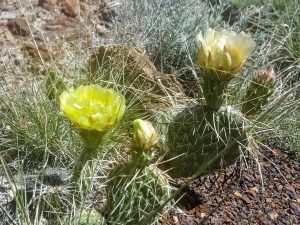My BIG Alberta Backyard – Midland Provincial Park

It's easy to see different layers of rock in Midland Provincial Park. Each layer can give scientists important information about life millions of years ago. ABIGAIL STOSKY
BY ABIGAIL STOSKY, NATURE NETWORK ASSISTANT
Alberta is a great place to live. It’s a big, beautiful province full of all kinds of natural wonders. This is where we introduce you to the diversity of wildlife, and unique and interesting wild spaces, that are part of your Big Alberta Backyard. This time, let’s explore Midland Provincial Park, just outside of Drumheller.
In the Heart of the Badlands
Midland was made an official provincial park in 1979. It used to be the site of the Midland Coal Mine, and you can still visit the old mining office today. It’s also the home of the Royal Tyrrell Museum.

Prickly Pear rely on bees to help pollinate them. ABIGAIL STOSKY
The park is surrounded by badlands. The Badlands are usually very hot and dry, so not a lot of plants can grow. Sage and prickly pear cactus are some exceptions, because they have adaptations to live without very much water. For example, cactuses have special stems with waxy skin which helps trap water. Many animals would like to munch on these juicy stems, so cactuses often have pointy thorns to help protect themselves.
Badlands Rock
You can find lots of really amazing rocks in the Badlands. Ironstone is a very common one. It is usually orange, brown, or red because there’s metal, iron, inside the rock that rusts when it comes into contact with air.
In fact, the Hoodoos that are found in the park are formed when a piece of hard rock, like ironstone, sits on top of some soft sandstone. The sandstone gets worn away by wind and other weather, but the harder rock doesn’t. Eventually, all that is left is a column of soft sediment with an ironstone “hat.”
Another common type of rock is bentonite. Bentonite is extremely soft and crumbles easily. It often looks “wrinkled” or has a popcorn texture. Bentonite can soak up almost 10 times its weight in water, and becomes very slippery. It takes a very long time to dry out. Always be careful when walking on bentonite so you don’t accidentally slip!
Where Dinosaurs Roamed
Midland Provincial Park is most famous for the fossils that have been discovered there. Some fossils can even be found lying right on top of the surface of the ground! But if you find a fossil, be sure to leave it alone. It is illegal to take anything out of a provincial park (even a wildflower). This is especially true for dinosaur bones. Dinosaur bones across the province, whether they’re found in Midland or your own backyard, all belong to the government. It seems like a strange rule, but this is so that people can’t sell the fossils to private collections. Instead, the fossils are given to scientists so that we can continue learning about these amazing creatures from millions of years ago.
If you’re interested in searching for fossils, the Royal Tyrrell Museum offers fossil-hunting programs in the summer. They also have a fantastic interpretive trail near the museum where you can learn even more about the amazing badlands of Midland Provincial Park. Who knows what you might discover?!
This article originally ran in Nature Alberta Magazine - Spring 2022.
